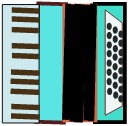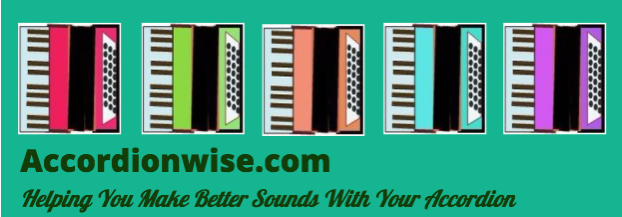I HOPE YOU ENJOY THIS WEBSITE
My name is Alex Govier, a professional musician on accordion, piano and organ for over 50 years.

On this website I am sharing stuff to
- Improve your technique
- Help you get to know your instrument better
- Play more easily and more confidently
- Try new accordion bass methods
- Integrate bass and treble sounds in different ways
- Learn how to make better music
- Gain popularity with general music listeners and not just fellow accordionists.
And yes, ALL CONTENT ON THIS WEBSITE IS FREE.
Simply because I would like more general appreciation of this wonderful instrument.
Because by playing a little more thoughtfully we can reach new audiences and get more recognition.
Find when there is new stuff on this website by joining our new Facebook Community
Here you can also
- interact with this website on Facebook
- Ask questions
- Request more detail on an accordion subject
- Suggest a new subject
- Tell us your own ideas and more.
The Accordionwise Friends link
You can find my personal playing sites on
Let's face it, that thing that makes the accordion so easy to start playing, the fixed oom cha cha, or oom cha oom cha bass line is not the most musical sound to listen to for 64 bars on end. The good news is that playing those hackneyed patterns always remains useful but should be regarded as only the basis if you are to play really musically.
In fact there is another way of playing that is even easier technically, except that you really have to think about what you are doing until it comes naturally.
![]()
What to do if your Accordion bass Sounds too Loud
I have just been reminded that the accordion bass sounding embarrassingly loud in comparison to the right hand melody is proobably the number one fear of accordionists, particularly relative newcomers to the instrument.
I would suggest these points, after making sure you were not using obviously unbalanced sounds like a full bass with a single reed or middle tremolo treble sound.
- Does it sound loud because it does not really fit in or has been played the same way in the piece so many times that it is embarrassing. If so this whole page is hear to help you play more creatively.
- A common solution suggested is to play the bass stacatto. While this works it may leave you unable to hear any harmony, which is what your left hand is there to provide. A partial solution to this is to join the bass Note with the chord and just cut the chord short, or the first of the two chords following in basic waltz time. So at least you know what the chord is roughly, identified by its bass note.
- My feeling is that even mechanical stacatto playing all the way through sounds better if the right hand is playing more than one note of the chord, even if just playing in thirds (the note next but one below the melody in the scale of the key you are playing in). Full chords in the right hand and the harmony is obviously explained in full.
- It is likely that the bass is most likely to overpower a flurry of right hand notes. That is to say when the melody starts playing in quavers (eighth notes). So simply stop playing when this happens. The whole tune will lighten up and sound so much more free if you do this. Listen to the top jazz players and they will not obscure their purple passages with bass notes, though they might reinforce interesting chord changes they are playing, and in that case the left hand is being useful.
- The reverse of playing staccato and playing smooth legato may also work in a strange way by creating a more continuous sound.
- A bass chord repeated rather than held through will be more obtrusive. A long chord particularly if the bellows is used slower part way through it will sound lighter, and if the melody note before it started was played strongly as is likely the memory will remain of it being in charge.
- A long bass chord WITHOUT a bass note sounds lighter. OR with a very quick establishing bass note played at the beginning.
- Really think what notes you are playing in the bass rather than do the mechanical stuff all the way through. Then you will not worry about it being heard
More Fluid Bass Playing
Basic accordion playing is characterised mainly by matching movements in the left and rioght hand - melody note is accompanied by one chord or bass note etc. This works but if continued for long becomes stodgy and uninteresting.
A main method for improving this could be summarised as fast notes with slow or vice versa as a general principle, not fast with fast which is overdone and a confusion of sounds, nor slow with slow, which is boring.
Or even no notes with fast in the other part can be an idea.
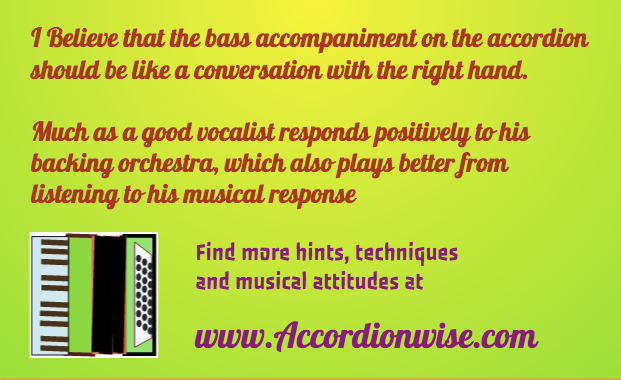
![]()
Creating More Interest
Several quick notes in one hand accompanied by one long note in the other hand is more interesting to listen to, or even when one hand stops to let the other hand shine through, - common politeness, and lets your purple passages be heard and appreciated!
This can happen on a note to note basis inside what would otherwise to vary your fixed rhythm pattern.
Sometimes this can be at the very beginning of a tune
An easy to spot example of this is where a tune starts in the course of the previous bar in quavers (eighth notes) such as The Shadow of your Smile. The accompaniment pattern of course is not played until the word Smile.
I think this is called an anacrusis, but it is not important to know the fancy name as long as you can recognise it as an incomplete bar. Just feel the difference!
Only Just Too Late
Notice that melody starts very nearly at the beginning of the bar, only half a beat late, but the principle still applies. In fact this type of long preceding run is most effective as a device to delay the rhythm pattern, whether in 4/4. latin tempos (Quando quando) or Waltz.
This does not apply when the bar is complete, even if it starts with a run of notes (Die Fleidermaus for example starts on the first beat of the bar so with that tune you would be playing the bass pattern from the beginning)
![]()
Create delays for smoother results
In cases where all beats of the bar seem to want to coincide there is another solution to the stodgy obvious one.
For Example Love Me Tender, the Elvis classic. This could be really dreary if played note for note and yet you still want to feel the slow four beats in the bar.
Therefore you delay or advance one or two of the notes by a half beat.
Bringing the note forward in the melody is called syncopation, but is in fact a very smooth effect sounding quite casual if you play it with aplomb.
![]()
Play like Sinatra
This is the phrasing technique used by great popular singers, such as Sinatra. By manipulating where the notes occurred he made a more flowing piece of music.
This can also be use to make fast songs manageable to sing and slow ones move along without losing the overall tempo.
Delaying a bass beat will give you a dotted bass beat which is a little more jagged tempo, but if on the last beat it will link you very firmly to the next bar
As a friend of mine recently pointed out, this is like playing as if you were a singer (and thus playing it more eloquently and without fatigue)
![]()
101 thoughts on avoiding monotony in the bass accompaniment
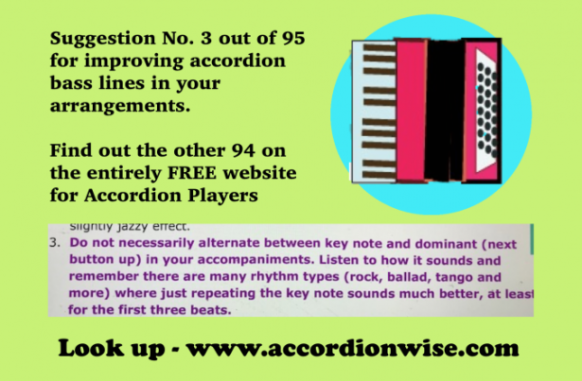
Don't worry the bass hints are right here below,
Who wants to hear the bass section doing exactly the same things 32 or 64 times in a row? Obviously it needs to be varied so here are some methods once you are confident of the feel and tempo of your music
Some of these ideas are dealt with in more detail elsewhere in the website - but obviously not all 95 of them! By all means please let me know which ones you would like me to try to cover more fully, maybe with written music, audio or even video examples as I find time to do so.
An email link is provided at the bottom of the page.
NOTE: Different colours and fonts are used in the ideas list below to make the individual items stand out - the ones shown lightly in black can be just as important as items in bold red, etc. It is just my attempt to make it easier to read by separating the different ideas visually.
- Do not play bass buttons right through fast runs or fast notes in the melody, but leave gaps while that is happening to avoid confusion.
- Do not play bass at all at the beginning of a tune in these conditions. If the tune starts after the beginning of the first beat of the bar then wait and bring in your rhyhm pattern on the first beat of the next bar (example Shadow of your smile but frequently occurs on faster tunes). A very professional and slightly jazzy effect.
- Do not necessarily alternate between key note and dominant (next button up) in your accompaniments. Listen to how it sounds and remember there are many rhythm types (rock, ballad, tango and more) where just repeating the key note sounds much better, at least for the first three beats.
- Whether playing simply or with more complicated patterns never repeat the same exact pattern (even with different chords) more than three times and often it is better to make two your maximum. This also applies to the right hand and is a basic principle of how to avoid annoying your listener.
- You can use the limitations of your finger stretching to help you find the right notes. For instance if you can only just stretch down to the minor third bass note (with either 4th or 5th finger) that is a secure way of knowing where you are. Likewise if you have to jump one or two buttons to make it that is also an excellent clue about where you are.
- NEVER play without thought - a tall order when you have trained yourself to do so much automatically, but put the thought in as much as you can for the sake of the listener.
- Regardless of how cautiously you keep to the three basic chords inside a single left hand postition you have almost certainly not yet used all the interesting combinations of the notes. If you do not believe me just try A D C# A D then D minor, which is a bit of a mind twister which requires careful fingering! Then if you can, do the same pattern from different notes.
- Obviously bass runs between chord changes is useful. Note that they need to fit exactly and stop where they need to be without over-running the beats available however.
- If your bass run is too short you can add a turn (most likely at the beginning) to give you an extra note or a chromatic movement between a couple of the notes.
- If the run is too long to reach the proper destination you can cut it by halving the note value to double speed of a couple of the notes. Probably better than cutting out notes.
- Use the bellows as carefully to bring out the left hand as you do for the right, so long as it does not interfere with the overall expression in the overall sound
- Beware of putting increases in volume right at the end of your chords if you can manage. Tapering volume on the chord is good if you have time for it and it does not interfere with other parts of the music.
- Obviously it is always good to make sure you have a good balance between bass buttons and treble keyboard but sometimes the bass part will sound annoying just because you have not selected a good bass pattern or method to use!
- It can be just as important to vary the attack or duration (from stacatto to legato) in successive bars in a bass line as in a melody line. Paying attention to this may be the first step in rescuing an annoyingly repetitive bass line.
- Particularly in a slow to medium tempo you may play a note for note independent bass line to a half beat run. Sometimes a standard bass line between the bass notes for the main chord change such as a four note lead or a section of chromatic scale will sound logical regardless or even suggest to the ear some complex chord changes you had not even thought of!
- In some ways playing a simple four beats to a bar in the bass can be the most difficult to improve in comparison with when you have more finger movements to swop around. One of the simplest ways to avoid that annoying repetitious effect is not to play so automatically but vary the ways the sounds connect to the next one by varying duration of button pushes without disturbing the rhythm.
- The next easiest way is probably to use the note to chord repetition on only alternate bars. A good and easy sound for the second bar might be note chord then key note (eg C) and alternate bass (eg G)
- When you find something that works do not overuse however, normally only three in a row maximum then something different so you might have on the fourth pair of bars note chord note chord note note note note (run)
- Sometimes a sustained chord will sound better than repeating it, in fact can be very satisfying musically or a short chord leaving other parts to take prominence of course.
- Remember that you have a choice of either reinforcing a series of notes by your bass playing or making it more subtle by leaving it to the right hand only.
- You may also use bass notes and chords together for extra weight and emphasis. What I call seesaw playing of EITHER note or chord is not always right or even effective. OR to create a different chord by combination.
- You can make a rhythm pattern instantly blend into the overall sound and avoid distracting from full bar or longer melody notes by reducing bellows pressure. They are instantly softer in comparison to the impact of the long note which has already been noted by the ear. NB this is the same technique which allows an extra part to be heard as different in the right hand.
- It does not have to be difficult to find notes that will add variety to a bass run, this can be as simple as playing in the order CGFC for example, possible even on a 12 bass accordion!
- On larger than 12 bass you can create even more easy to play bass note phrases with the obvious major 3rd right there for you on the counterbass row, or the equally close semitone below on counterbass (physically diagonally above of course) or even the full tone note above or below which will only be separated by one button vertically.
- You may often find it a more practical way of finding the bass note a full step above by going from standard bass to alternate counterbass below. It usually keeps you better in the area of the keyboard where you need to be. It is slightly more difficult to understand why it works as it is so easy to use the alternate note above in the same row.
- For staying in touch with where you are on the keyboard, fast playing of runs, full control of phrasing (being able to join up notes and vary the duration of notes for emphasis rather than seesaw), exact timing, musicality (separating or building up the sound by overlaying and treating the bass part as important) and ease of finding notes it is best to keep the fingers close to the bass buttons rather than punch from two inches above the keyboard.
- A small finger movement (i.e. up and down on the button) is as positive as a large one and you do not need exaggerated movements which give a degree of uncertainty as to when the note will actually be pushed down!
- Raising the fingers above the notes does give you a wider arc for finding awkwardly distanced notes howeve. This can be useful if you find even the minor third difficult to reach or the extremes of finding the same note somewhere else on the keyboard. It should be used consciously and not used as a habit as it is much easier to ensure you are in the right place by being in contact with the buttons at all times. Large movements may also slightly disturb the timing.
- On occasion in a heavily syncopated brief phrase in a swing tempo particularly, probably a maximum length of one or two bars you can reinforce the notes for musical effect by playing note for note with right and left hands. This can also be useful for example with crotchet triplets which are supposed to stand out musically anyway.
- Remember that it is not only the bass buttons that supply the overall rhythm, the right hand melody can be supporting the flow and rhythmic impact also.
- Where possible (except on the first beat of the bar) leave the bass out when the melody is playing in fast notes. It may be that a continued chord held through the new note will be fine, however. It need not be a rest, just not a new bass attack.
- To combat lumpiness shift either a bass note or a melody note forward or back half a beat so that not all four beats are duplicated (doing this on the bass will alter the feel of the tempo slightly but can be OK or even useful sometimes). Phrase your melody freely like a good vocalist.
- Avoid note to chord phrasing generally in order to add movement and lightness, moving more in one hand than in the other rather than putting out the tones always at the same time. This can be done by adding longer notes (minim or half notes for example) or faster quavers (eighth notes) in right OR left hand.
- Remember there are many possible single note bass patterns. You have three notes which create a mini arpeggio of each major chord, e.g. C E G and there are actually SEVEN different ways you can organise those into a three note group.
- You can also play the notes in a straight line associated with a particular key centre in six different orders. You can do tht in a 12 bass accordion!
- If you deide you are allowed to repeat one of those three notes once to make a four note pattern instead of a three note one you have a lot more possibilities of course.
- A very musical sound is created by playing the right and left hand SEPARATELY in rhythm. Sounds like a contradiction in terms, but the idea is to phrase the tune freely (not quaver matches quaver etc.) while the left hand keeps rhythm more strictly.
- Varying an over noticeable rhythm can be done by simply not playing the last couple of beats of the bar or by playing extra notes or chords
- You can also very usefully vary the beat by keeping the same beats but reversing the notes from note to chord over to chord then note!
- Reversing the order of using either notes or chords will often work even if you have not worked out the exact effect and can still enhance the freedom and style of your playing.
- If remixing the order of your notes to chords remember that the chord will always sound higher than a single bass note for placing the light feeling into the rhythm. (Sorry if this is difficult to understand - just try it and see)
- There are three basic ways of using your bass buttons not just two! You have bass or chord or bass WITH chord! Mix them into your playing as sounds best for the style and even the bar you are at in the music.
- Holding the fifth note instead of the keynote WITH the major or minor chord adds a particular significance to the chord, adding a feeling of ominous expectation as to what is going to come next.
- Do not be afraid to add a triplet link in a rhythm where it is not standard. It will add a feeling of lightness and freedom to your playing. Also vice versa and crotchet triplets can be useful also. These do have the opposite effect of course, of making the playing more emphatic at that point.
- Play extra faster notes on the bass when the melody seems to have gone to sleep. This can mean bass runs to link between lines of melody of course as long as intended to be noticeable. Use the alternative order for bass and chords instead if intended to be less intrusive
- Change to a different rhythm momentarily (just an ordinary alternate bass chord bass chord can sound OK for a while if you have already laid down a complicated strong tempo (a tango or rhumba beat previously, for example) The listeners ear needs a rest occasionally and will fill in the memory of the rhythm you are in.
- Double up at the end of the bar to quicker quavers (eight notes) - either the last beat or the last two beats (good for linking to a new phrase or to an odd numbered bar)
- Insert a "rolled effect" for emphasis or linking to next bar (like a fast trill but between bass note and chord instead of between different bass notes)
- Link to the next section with a logical run between the notes for the chords bing used
- You may vary the pattern by cutting to a couple or more of bass notes instead of the existing pattern.Most easily and obviously you may use the major third from the highly available counterbass row or more subtly choose the note a tone below or above your key chord note. Those are easy to find too, with only one button between.
- Try playing full chords instead of bass notes, just one example instead of C G A G, try Note C - Chord G - Chord A minor - Chord G. Here A minor is suggested because A Major would have used a C sharp which is outside the key of C. Another nice smooth variation like this is going straight to the relative minor such as Chord to A minor, or Bb to G minor, or D to F# minor etc. This is a fair distance of course
- Play any standard or usual pattern for you but swop bass notes for chords and vice versa. Again quite easy to do on the last beat or two beats of the bar, but this is a more subtle effect relieving the strain of repeated pattern on the ear and not necessarily inferring a new section after it. You can invert even a complete bar or two if the pattern has been well established first.
- Insert an especially emphasised main bass note by leading it in with the chromatic note under, or even two chromatic notes under taking no appreciable extra time to do so and not disturbing the beat at all - be careful where the emphasis from the bellows is, it should be on the main note. (You will need a very good knowledge of fast chromatic runs for this!)
- A very strong effect is to phrase with the melody for half a bar or a bar, good with crotchet triplets or to match a strongly swinging or heavily syncopated section of tune.
- Substituting bass notes only in the left hand in bars where you might expect a more standard alternate bass chord approach or a specific rhythm. This might outline a chord using your three easy bass notes around the chord if there is a constant chord at that point.
- Use bass note outlining to suggest "impossible" chords like augmented chords or suspended fourths (or demented 23rds)
- Play only on bass notes ignoring the chords, leaving the bass free to roam walking bass style and the right hand to define the chords.
- Chromatic runs note for note against a single note right hand run can suggest chords you had n't actually thought of!
- Use the power of chromatic runs, particularly in contrary motion against a chorded right hand for some rich and interesting harmony
- Explore the different effect of simply holding the higher button (the dominant) alongside your chord, hence playing G with C chord, D with G chord, F with Bb chord etc. It creates a feeling of anticipation or tension if held which the matter of fact standard same bass note will not give you.
- You can play the tune for a few notes, or a whole phrase or two, where suitable on the bass (in octaves) as well as the treble keyboard for an octave effect.
- You can double the tune on the bass one third or one sixth interval lower (this will however infer different chords, eg C under an E (a 3rd) would say a chord oif C where as a G (a 6th under) could also mean an E minor chord)
- A very gentle effect is to replicate a piano style accompaniment for a light ballad is by playing chord to dominant note (eg C chord to note G) on every note of a four beat bar. Or just on the last beat of the bar or the third and fourth beats. (Think Memories by Barbra Streisand not Memory from Cats)
- A simple standard bass line can be enhanced by adding quaver (eighth note) one octave arpeggios under the tune in the right hand. This gives a very good flowing effect.
- You can also alternate playing chords on the right hand with the left for a lively effect, or move across from bass note to bass chord to right hand chord (in one or two positions depending on what you want to sound like and on how many beats remain inside that bar) for a smooth almost arpeggio style effect.
- Use left hand sustained chords on their own either without the bass note or with an initial bass note first. How long you keep the bass note going against the chord will alter the apparent volume and balance.
- Use a long sustained chord with the bass note line moving under it as an extra part (even if only popping in the chord note and dominant, eg C and G with C chord)
- Explore the possibilities of extra bass countermelodies appearing miraculously by playing chord to chord without bass note. Some will require wide spacing, eg C to A minor and the use of the 5th finger.
- Chords which do not modify the key you are in are includes from major up on the bass buttons to minor (and of course back works too if starting from minor, so minor to major below also)
- Be aware that not all these will give the upward or downward effect you were expecting because of the way the reeds are chosen from the chords (normally inside a single octave range C to B). Be happy with what you get or make a note of what happens when playing in particular keys.
- This can be complicated but almost any chord change will sound OK even if you miss the exact right one and your listeners will not know if it was intended or not if it is momentary change. (I shouldn't tell you this!)
- BUT VERY EASY. You can also do very effective quick chord shifts as a decorative embellishment even inside the chord name you are working on however. You do not change the overall harmony with this when you return instantly to the original chord. Even G to G7 and back may work if you play each chord distinctly. However going from major or minor to diminished will always show up because of the note shifts happening inside the changes. Because you are not changing the trend of the harmony you can choose which one seems best.
- Expand beyond the chords you think are possible by going to the EXTRA CHORDS PAGE here
- Use dissonance and make a big sound by layering different chords onto the left hand chord from the right hand section and resolve on the next beat on to a less dissonant chord. You can delay the resolution by going through several logical (within the context of the right hand part) but dissonant right hand chords first. You can also tease by putting a false note into the next chord before allowing the final resolution. Or making the resolution lag behind.
- A few notes from the chromatic scale can be used instead of the impossible full chord chromatic slides (which are easy on piano or guitar) either WITH or WITHOUT the full chord being played in the right hand. NB you can do a chromatic chord slide down like C B Bb A with just the bass notes or with chords added only on C and Bb
- Try chord substitutions for impossible chords to play or play bass notes only for the impossible chords
- Play the "impossible" chords only on the right hand!
- Explore the possibilities of using the little finger left hand and the places where it will be easiest for you. But only use it where it does not disturbed the rhythm or the relaxed confidence of your playing.
- You may find that the fifth finger is easier to use in the sharp keys rather than at the lower end of the button keyboard because it may line up better with the single note buttons rather than being pulled back towards the chords (being shorter and closer to the outside of the accordion). Particularly if your left hand is angled upwards at this point.
- If using the fifth finger it will be more secure if it is the first note of the run you are doing, or if it prepared in place before you start the run if it is later in the run.
- If the fifth finger seems difficult to use straight up and down plunger style, you will probably find squeezing the hand together into a slightly tighter fist will make it work. This just brings it down from a diagonal direction instead
- Use chords alone on the bass instead of with bass notes for a lighter sound. Try holding the chords and quickly releasing the bass for a combiination of the strength given by the bass and the lightness of the chords. Listen to the effect of releasing the bass notes at different speeds which will lighten the effect with more stacatto bass notes, or of course retain the feeling of a bass line more if held longer.
- Use chord only on one to a beat, or two or three on a beat. If more than one you may be returning to the first chord. NB you will this time not have a bass note in between the chords in this instance.
- Try the alternative seventh chord shown on the EXTRA CHORDS page if you have a six row bass
- If you have a five row bass accordion (60 or 80 bass) and do not know how to get diminished bass chords also read the EXTRA CHORDS page
- If there is an awkward gap between lines of a song, you can either link it in with a bass line or sweep up or down to it with a lead in link to the tune in the treble (dealt with on the right hand tricks page, coming shortly)
- Another way to link two phrases of a tune with the left hand is to play several notes (ie a triplet or semiquavers) on the last beat of the bar before the new phrase starts. This may even bre the same buttons you are using in the rest of the bar. Be sure to know where you are on the first beat of the next bar however!
- Play the tune on the bass for a while, this allows you to produce totally unbelievable accompaniment styles with the right hand! Choose your bass sounds for this and make it more convincing by applying the same attention to detail to the bass line as you would if it were played in the treble. This includes putting the emphasis where it should be in the bar, crescendo and diminuendo with the bellows, and phrasing it with true legato bass note playing mixed with breaks between phrases. When you add a free flowing treble part to that it will blow your listeners' minds! You may do this easier by adding the right hand to just the last couple of notes of the phrase.
- Use just one position of one of the two boogie bass systems (explained on another page) as a linking run
- Choose your methods according to whether you want the effect to be noticeable or subtle. Bass notes only patterns tend to show up, chords alone less so, and of course different orders of note to chord or chord to note is appreciated on a subconscious level
- Either simplifying or adding extra detail to a bass pattern is useful and either could be used to highlight a change to the next phrase or section of the music for the listener.
- If your bass pattern grates on you when you listen to it closely (as you should always do!) ask yourself what is the annoying feature and do something different
- Try the very pleasnt sound of a held bass chord and moving bass button notes against it instead of the common seesaw pattern
- If you have only a five bass row accordion You CAN still play diminished chords. On most accordions just play the normal seventh chord one button below and add the diminished note (the flattened fifth) in the right hand. to get Cdim7 play F7, yes really.
- And both five and six row players can play Augmented chords by using a sharpened fifth in the melody with your normal 7th chord (but not the major or minor). This is actually a 7th chord with augmented 5th but is like an extra jazzy augmented chord. So for C augmented use C7 with G sharp in the treble.
- So on six bass row accordions you have an alternative normal 7th chord by using the diminished above, a 7th chord with an augmented 5th in it by playing it in the treble without a clash, and an alternative version of the diminished chord on the button below the 7th chord
- Try playing fast awkward chord changes by putting one chord in the left and the other in the right hand, it actually sounds better and livelier than playing them both in the bass. Wonderful sound if you play a trill between them!
- The limitations of all of your bass notes being produced from only 12 notes should mean that the notes will not always go up when you want them to or down when you want them to because there may be a break in between. However if playing with a 2 or 3 reed bass combination your ear will hear the most likely and therefore the most melodic sounding transition.
- This means you CAN play a one octave up and down arpeggio including a different top and bottom note as long as you play them in the right order. See the section on this website for this.
- You can use more than one of these methods and thoughts in one tune. In fact you SHOULD use at least two different ones to distinguish different sections (eg verse chorus, middle eight, trio section etc)
- Remember to play as if you are telling a musical story, not merely playing the right notes. This may mean using different methods of styling where you wish to emphasise the importance of a particular part of the tune
- Read this list slowly very slowly and pausing on each one approximately 25 times!
Watch out for further thoughts here which I have probably so far overlooked! Oh and copy and paste the hints I have not properly explained for you to email me about
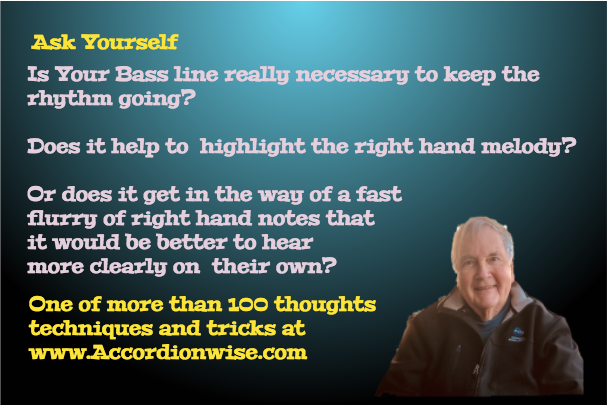
Alternative waltz note and chord patterns
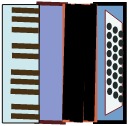 There are so many possibilities even when playing in just three beats to the bar.
There are so many possibilities even when playing in just three beats to the bar.
I will give you some written music first but for non readers after there will be a very full alternative explanation you ahouls be able to understand
FIRST THE WRITTEN MUSIC
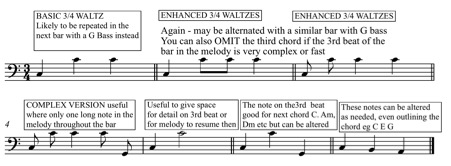
To describe these alternatives let me use the terms N for bass note and K for chords (Kords!) so as not to confuse you with the chord or note C
Very basic familiar beats are explained in the next paragraph to get you used to the system, not to insult your intelligence.
Your usual basic waltz rhythm is played as N K K and your basic four beats in a bar is played as N K N K right? With the 4 beat version your second N may possibly be the alternative bass note. I think we can all agree on that!
Remember the K refers to a kord button as in German usage so it does not suggest only the chord of C.
But even the basic can be played musically by varying the attack and smoothness whether staccato or smooth between the different beats. For example in
N K K joining the first and second beats N-K N-K , (I have used a hyphen there to indicate legato smoothing to the next note - you might even overlap them slightly, it will add a lot of tone to your sound and sound nice too)
Some possible Variations
Here are just some more variations for waltz time which include some with helpful lively quavers (eighth notes) indicated by being typed closer together
- N K K
- NKK K (COUNTED 1 AND 2, 3)
- N KKK (1, 2 AND 3)
- N K KK (1, 2, 3 AND)
- NNK K (! AND 2, 3) For this you might like to use the alternate bass or counterbass for the 2nd Note
- NNKNKN (1 AND 2 AND 3 AND) after the first N the others will sound good on the counterbass, playing the 3rd of the chord This one is good training for one of my more revolutionary suggestions later on.
- N K (1 2 and think 3 but dont play it!) This allows space for the tune to carry on without being sat on, think (Carolina) Moon K Keep (Shining)
N K N is Good for linking on to the next phrase of melody (as in a fourth or eighth bar) The second N willl be a different note than the first, most probably the dominant (the button above in the same row, suc as G for a C chord)
Also you can use just notes of course as runs with these examples N N N or NNN N or N N NN or N NN N or even NN NN NN all of which being a bit more noticeable are good for leading strongly towards the next phrase or set of four or eight bars.
There are also suggestions for playing some of the chords in the right hand on another page.
![]()
AND A FEW PATTERNS IN 4 TO THE BAR
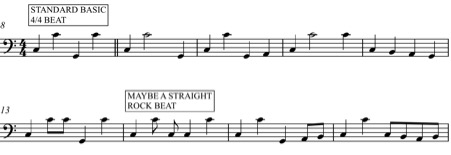
Shown above In order you have N K N K (standard 1 2 3 4 )
then N K N (count 1 2(3)4)
then N K K K (count 1 2 3 4)
then N K K (count 1 2(3)4)
then N N N N (count 1 2 3 4)
LINE 2
then N KKN K (count 1 2&3 4)
then N KNN K (count 1 2&3 4)
then N K N NN(count 1 2 3 4&)
last N K N&N&(count 1 2 3&4&)
Note that the note runs are to show you where the runs might be incorporated but the actual notes shown are only suggestions
There are lots more possibilities we can deal with under specific rhythm styles on another page.
![]()
A VERY BASIC WAY TO AVOID MONOTONY IN 4 Beats in a Bar
SO EASY AND YET SMOOTH AND PROFESSIONAL SOUNDING
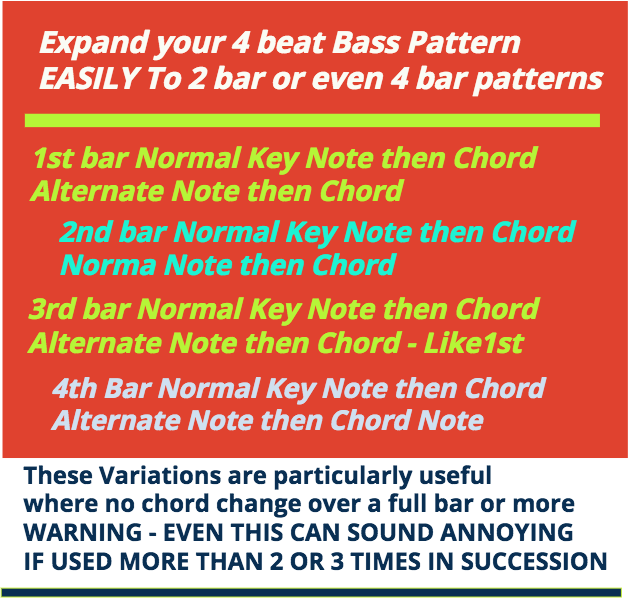
This is a Four Bar sequence. Those modern auto-play keyboards mostly can only manage two different bars before they endlessly repeat (unless you take your hands away from the keyboard to press buttons on the control board).
As they can generate complex 2 bar rhythms these quickly beome repetitive and annoying.
Unfortunately a lot of accordionists are happy with one bar accompaniments that repeat even more and there is little guidance around as to how to get out of this.
So by plahying a four bar section you will be sounding more musical than those amazing keyboards for all their flashing lights/1
And it is not at all difficult. Here is just one solution.
First bar is "normal" with alternate bass note between chords (e.g. alternate note is G if a C chord)
Second bar is even easier providing you have control over your left hand, you play the same basic key note on the 3rd beat, the key note or C again if a C Chord
Third bar is just a "normal" bar with alternate bass notes the same as the first bar and your most likely option you are using already.
(You could also vary it, perhaps using the counterbass note instead on the 3rd beat, with the chord of C, E instead of C)
Fourth bar has just notes on the 3rd an 4th beats, most likely in the order alternate note back to key note. This makes an unobtrusive but effective lead in towards the next bar, the beginning of the next phrase.
The notes on the 3rd an 4th beat can be varied, in reverse order or perhaps from the counterbass to the alternte bass (E to G with a C Chord).
![]()
EVEN THIS CAN BE ANNOYING IF REPEATED BLINDLY ON MORE THAN TWO OR THREE SUCCESSIVE 4 BAR PHRASES - You can always come back to it later and bear in mind you go on to a middle eight or chorus with a different emphasis it will sound good with a contrasting treatment.
The fourth bar can also CUT after 1st or 2nd beat to allow the right hand to take over if the tune suggests that by starting again after the first beat of the bar
The fourth bar could also be more complex with a quicker flurry of notes from the 3rd beat to the 4th as in Note chord Note-chord-(quavers, eighth notes) Note, or experiment to find your own
TRY IT ON MOST 4 BEAT TUNES FAST OR SLOW
NOTE Do not start the sequence UNTIL THE TUNE HITS THE FIRST BEAT OF THE BAR!
When you're Smiling (When you're - SMILING)
For me and my girl (The bells are - RINGING)
Sunny side of the street (Grab your COAT)
If a melody starts on the first beat of the bar you are OK to start with the tune as you might expect. You do not need to adjust by waiting.
![]()
The Rule of Three
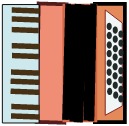 We might as well get this over with now. It is a basic psychological feeling with repetition. And it also applies to what you do in the tune as well.
We might as well get this over with now. It is a basic psychological feeling with repetition. And it also applies to what you do in the tune as well.
The first time you play a bass pattern is the first time so it is lovely
The second time you play something exactly the same it is nice because you recognise it.
The third time it is an acceptable reminder
And sometimes even the third time is too much!
The fourth time it is downright annoying.
This is particularly the case if you are perceived to have done something rather clever! And which is particularly noticeable.
So try not to repeat the exact way you play something more than three times in a row.
This is also the case with a clever decoration applied to a melody and is another rule to prevent boredom.
You can do the same permitted repition of course in another line of the tune or a different part of the composition.
This is also an excellent rule to follow for a marital qua-err discussion
![]()
Demonstrating my basic principles
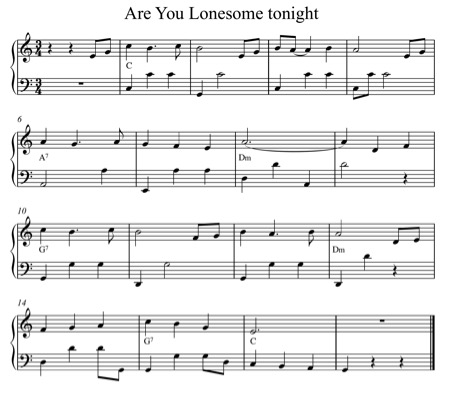
There are two places where I more or less broke the rules here, but for musical reasons. On the first complete bar there are three beats and three notes, usually undesirable but play the third beat late (on the last quaver of the bar) and it lightens it because they are no longer hammering away at the same time.
In practice I might have played the harmony into the right hand part with full chords under the first notes in the first four bars and added running thirds under the melody afterwards. But this would have made for a more complicated score in appearance and to write out in Sibelius!
Modifying the timing of the melody like this is a nice way also to make a more free less regimented effect, even when otherwise playing in perfect time.
Later on I also suggested the full “normal” pattern of Bass Chord Chord with the words Sorry We Drifted Apart to strengthen that part of the tune and avoid over repetition of the “Clever” bit.
This is only a basic version of the way I would play it, to highlight mainly the places where I would simplify or augment the bass part, to avoid conflict between the parts or add interest and flow to the music.
![]()
How to Play in 12/8 time, Compound time, or playing in triplets
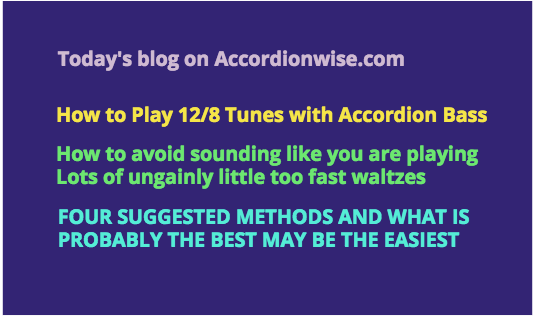
12/8 time is basically a slow four beats in a bar with each beat divided into three instead of the more normal two quavers found in 4/4 etc.
While the ideal is to avoid mini-waltzes inside the 12/8 tempo as much as possible (except for special effects of emphasis for a bar possibly) the main problem is when you make this sound the norm.
FIVE If you find yourself playing NKK at the beginning of a bar if followed by a KNK or even a NKN can prevent the mini-waltz effect taking hold.
SIX if you are familiar with going down to the level of semiquavers or 16th notes these can be incorporated usually inside the triplet. Usually instead of the second quaver of the 1st, 2nd or 4th main beat triplets. Best not to do them on successive triplets probably.
For example (the shorter quicker notes are in lower case)
NknK NKN NknK NKN or
NKN NknK NKN NknK
SEVEN
Pardoxically a linking bar to the next phrase of the tune can be effectively emphasised by simply playing N K N K as in the most basic form of playing giving up the triplets for a bar.
A nice rock triplet beat (As in Blueberry Hill, I can't Stop Loving YOu as standard and others according to your own arrangemewnt ideas) can be achieved with an
N(kn)N NKN NknN NNN (notes in brackets optional but the time taken to play them is not, they must not "push out" the tempo!)
As in the example of the general shape
C Ck C - E Ck E - G Ck G - E G E
or even modified on the last beat with the A from the counter bass below
C Ck C - E Ck E - G Ck G - A G E
I have put Ck to indicate the use of the chord/kord of C rather than the note. I hope this is understandable by all, done to save time writing music and to work for non-readers also.
NINE
This extra quick movement style between alternate note and chord can be exploited nicely in other beats, spicing up beguine, rhumba, paso double even, where it puts in the movement without the spluttering reed effect normally accepted and with less strain on the fingers
later, I may even manage an audio demonstration of this. Which would be added to this part of the blog and/or part of a general page this is added to.
Playing More Bass Note Runs is dealt with in the Bass Tricks page but Maybe you can almost treat this, aside from the lower pitch as an alternative to playing Free Bass, particularly if you do not have it on your accordion!
It is assumed that the break every octave wil spoil your tunes, but if you give the ear a choice of octaves to listen to by playing in a multi octave register.
But there may be more to it than that. It has for example been stated that Some accordions choose their bass notes from C to B and exceptionally some, such as my Victoria put the break from A to G#.
So I carefully checked my Victoria and found by listening first to the deeper registers and then the higher registers that the drop back to the lower octave took place after B on one pitch of reeds and on G# on another.
SO THERE WAS VIRTUALLY NO OCTAVE BREAK MOST OF THE TIME. IF ONE PITCH DROPPED BACK THE OTHER KEPT CLIMBING!
So my Victoria is a very very specail instrument I thought, this is unique to it.
I went over to my Piermaria musette and found a very similar thing happening.
So perhaps our fear that playing melodies in the bass will not work because of the dreaded octave break drop is not entirely justified!
MORE 16-32 BAR SONG ARRANGEMENTS WILL FOLLOW TO SHOW HOW TO AVOID THE MONOTONY OF ONE BAR RHYTHM ACCOMNPANIMENT, TANGO, BEGUINE, CHA CHA, SWING PROBABLY - KEEP RETURNING TO THIS WEBSITE!
JUST AS SOON AS I RUN OUT OF NEW WAYS OF PLAYING ON THE BIG LIST ANYWAY BUT THESE KEEP COMING!
THAT IS NOT ALL, CHECK OUT OUR VIDEO PAGES FOR LOTS MORE IDEAS

